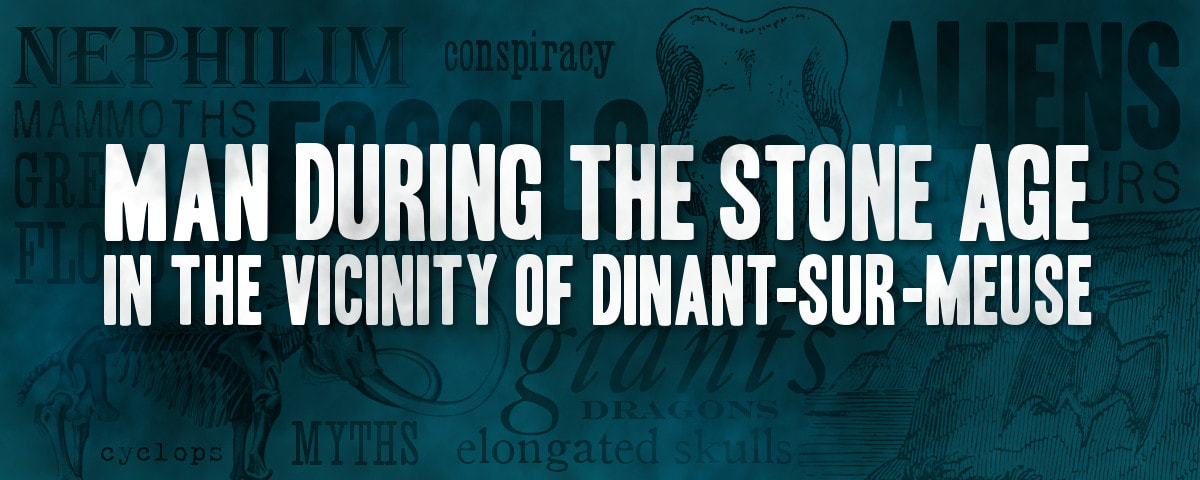Édouard Dupont
1871/1873
translated by Jason Colavito
2017
|
NOTE |
Édouard Dupont (1841-1911) was the director of the Royal Belgian Museum of Natural History in Brussels. He devoted much of his career to exploring the caves around Dinant, where, at Furfooz, he discovered the remains of a "Mongoloid" Paleolithic human termed the Furfooz Man. In these caves he identified a succession of "ages" based on typical fauna used for human food and the tools made for this purpose, beginning with the age of the mammoth and proceeding through the age of reindeer to the age of polished stone. We know them better as the Paleolithic, Mesolithic, and Neolithic periods In 1871 he published a multivolume work on Prehistoric Times in Belgium. The revised second edition contained a volume on Man During the Stone Age in the Vicinity of Dinant-Sur-Meuse, and the third chapter tackled the subject of giants. The text, while typical for its time, contains an interesting early effort to understand the religious life of Paleolithic humans through appeal to the myth of giants.
|
III. Man During the Age of Reindeer
[...] We have already made mention of a mammoth ulna found in the Chaleux Cave, on a slab of sandstone near a hearth.
The massive scree which has covered the habitation floor of this cavern imparts great value on the disposition of this object, for it furnishes us with proof that the enormous bone occupied this place during the time that people lived here.
Our Mongoloids had therefore placed this mammoth ulna close to their hearth with purpose. […] We can therefore ask ourselves whether the presence of this great remnant in the dwelling place of our Mongoloids is not a sign of fetishism: found underground by this tribe, it would have been considered as a witness to a superior race destroyed, just as popular belief has continued to do down to the present day.
If such an interpretation gives a satisfactory account of the circumstances observed in this debris, it is no less in keeping with the degree of development of these tribes. For if the moral side, as an illustrious thinker has said, is always so closely bound up, in a society, with the material side that one can surely determine one from the other, then admitting that our natives, having such a miserable way of life, also had a cult, what could we, a priori, attribute to them other than fetishism, the most rudimentary cult of all? To do so would only be to recognize them as an additional point of connection with those American, African and Oceanian tribes which have not yet experienced the influence of Europeans.
The Indians on the banks of the Ohio believed that the bones of the great mastodon, an animal that went extinct at the same time as the mammoth, of which it was the American representative, were those of a destroyed race of giants, and placed them in their huts to benefit from the protective virtue with which they were endowed.
However, in order to assemble here all of the elements of a serious appraisal, it must be mentioned that “according to Crantz, the Greenland Esquimaux ‘have neither a religion nor idolatrous worship, nor so much as any ceremonies to be perceived tending towards it.’ This statement has been confirmed by many other observers. Their burial ceremonies have, however, been supposed to indicate a belief in the resurrection.” [1] Moreover, the facts observed in the cave of Chaleux has not been repeated in any other cave from the age of mammoth and reindeer.
The belief in the existence of ancient giants as possessors of the Earth was until recently quite widespread among all the nations of the West, especially in the Middle Ages. It is generally agreed that we should attribute its persistence to the discovery, at long intervals, of the remains of the gigantic mammoth.
In every case, this is how these remains were considered when exhumed, and even doctors themselves, in a period before the birth of the rational sciences, fell into this aberration.
The great bones, so few centuries ago, struck the popular imagination so greatly in two localities, one in Westphalia, the other in our own province, in the abbey of Hastière-par-delà, where the bones of whales, brought from our coasts, were preserved in the annexes of churches as fragments of ancient giants. In the church of Hastière is the scapula which M. Van Beneden has cited in a communication to the Royal Academy of Sciences and in the osteography of cetaceans.
[...]
The massive scree which has covered the habitation floor of this cavern imparts great value on the disposition of this object, for it furnishes us with proof that the enormous bone occupied this place during the time that people lived here.
Our Mongoloids had therefore placed this mammoth ulna close to their hearth with purpose. […] We can therefore ask ourselves whether the presence of this great remnant in the dwelling place of our Mongoloids is not a sign of fetishism: found underground by this tribe, it would have been considered as a witness to a superior race destroyed, just as popular belief has continued to do down to the present day.
If such an interpretation gives a satisfactory account of the circumstances observed in this debris, it is no less in keeping with the degree of development of these tribes. For if the moral side, as an illustrious thinker has said, is always so closely bound up, in a society, with the material side that one can surely determine one from the other, then admitting that our natives, having such a miserable way of life, also had a cult, what could we, a priori, attribute to them other than fetishism, the most rudimentary cult of all? To do so would only be to recognize them as an additional point of connection with those American, African and Oceanian tribes which have not yet experienced the influence of Europeans.
The Indians on the banks of the Ohio believed that the bones of the great mastodon, an animal that went extinct at the same time as the mammoth, of which it was the American representative, were those of a destroyed race of giants, and placed them in their huts to benefit from the protective virtue with which they were endowed.
However, in order to assemble here all of the elements of a serious appraisal, it must be mentioned that “according to Crantz, the Greenland Esquimaux ‘have neither a religion nor idolatrous worship, nor so much as any ceremonies to be perceived tending towards it.’ This statement has been confirmed by many other observers. Their burial ceremonies have, however, been supposed to indicate a belief in the resurrection.” [1] Moreover, the facts observed in the cave of Chaleux has not been repeated in any other cave from the age of mammoth and reindeer.
The belief in the existence of ancient giants as possessors of the Earth was until recently quite widespread among all the nations of the West, especially in the Middle Ages. It is generally agreed that we should attribute its persistence to the discovery, at long intervals, of the remains of the gigantic mammoth.
In every case, this is how these remains were considered when exhumed, and even doctors themselves, in a period before the birth of the rational sciences, fell into this aberration.
The great bones, so few centuries ago, struck the popular imagination so greatly in two localities, one in Westphalia, the other in our own province, in the abbey of Hastière-par-delà, where the bones of whales, brought from our coasts, were preserved in the annexes of churches as fragments of ancient giants. In the church of Hastière is the scapula which M. Van Beneden has cited in a communication to the Royal Academy of Sciences and in the osteography of cetaceans.
[...]
Note
[1] Sir John Lubbock, Pre-Historic Times (London: Williams and Norgate, 1865), p. 409.
Source: Édouard Dupont, L’homme pendant les ages de la pierre dans les environs de Dinant-sur-Meuse (2nd ed.) (Brussels, 1873), 205-209.



